
|   |

|   |
Guru Smaranam - Tapati Chowdhurie e-mail: tapatichow@yahoo.co.in Photos courtesy: Srijan Chhanda April 25, 2022 Guru Smaranam was celebrated on 7th April 2022 by Rajib Bhattacharya's Srijan Chhanda in memory of Guru Kelucharan Mohapatra, one of the architects responsible for giving Odissi dance its rightful place with the other classical dance forms of India. The 18th year of the passing away of Kelubabu was marked in the Satyajit Ray Auditorium of ICCR Kolkata with the support of Central Sangeet Natak Akademi and the Ministry of Culture, Government of India. The hall was bursting to its seams with admirers of the Odissi guru. The presence of Guru Ratikant Mohapatra, son of the Odissi visionary, Kathak exponent Saswati Sen, and Paramita Maitra, Director of Nrityangan Kathak Kendra gave the event a different dimension. The evening was carefully packed with beautifully composed and choreographed Odissi and Kathak dance pieces. The Odissi legend Guru Kelucharan Mohapatra was held in high esteem by the Kathak legend Pandit Birju Maharaj. In fact, the two stalwarts of the times were great friends. 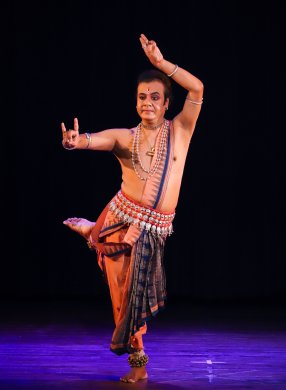 Rajib Bhattacharya A prayer offering through Pushpanjali by Srijan Chhanda and Rajib Bhattacharya flagged off the event with the 'Song of the Guru' authored by Vyasa. Ratikant Mohapatra's choreography of the piece to a composition of Sempagodu S Vighnaraja was a connoisseur's delight. Yugmadwanda Pallavi was an exhibition of pure dance, an exposition not only of the dance, but also of the music in Bagesri raag that accompanied it. The graceful and lyrical movement of the dancer's form was supported by intricate rhythm patterns of exceptional beauty. Together they created a beautiful tapestry of rhythm, music and movement, employing a significant innovation in dancers' movements, design and speed. It was a poetic piece through movement, a work of fine art by its maker Ratikant Mohapatra to the music of Pt. Raghunath Panigrahi. 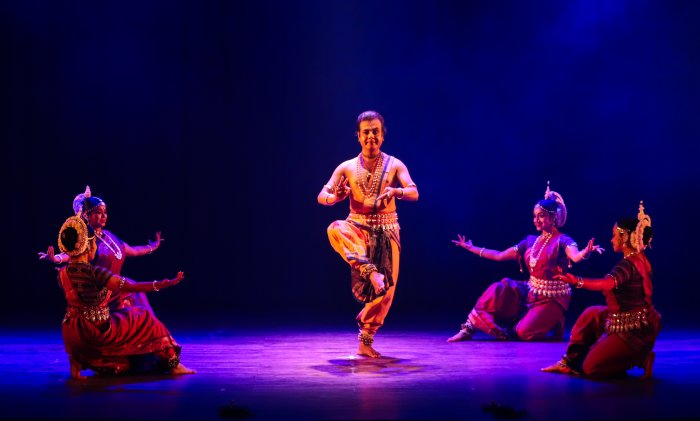 Rajib Bhattacharya and group An Odissi recital is never complete without an expressional dance. This time Rajib did a solo piece of abhinaya "Sun mana Hari ka naam kamana...," a bhajan in the Hindi language written by R.K.Pathania. The bhajan is a plea to mortals to keep the flame of belief in god burning in our hearts. It is god who rows our boats to safe shores from the turbulence of life. This bhajan with its tone of simplicity was expressed through the strains of raga Mishra Kaushiki Kanada in adi tala, with the restrain befitting a bhakta. It was more of a self-search of one's conscience to remember our maker whose love is unconditional whether you remember or forget her. Choreographed by Ratikant Mohapatra, the music of Pandit Hariprasad Chaurasia was like manna from heaven. Trisha Das, Ranjabali Dey, Rushita Mondal, Ankita Padia, Shrinjoyi Chhetri, Sumana Das Bhattacharjee, Angana Bose, Kamalika Bose, Shalini Sinha, Sritama Karmakar assisted Rajib in his neatly presented concert. Ratikant Mohapatra kept the banner of his father flying high. He has carved an enviable niche for himself as a dancer, percussionist, teacher, choreographer, and archivist. As the director of Srjan (Guru Kelucharan Mohapatra Odissi Nrityabasa), he has created a world class dance institute, attracting students from all over the globe for a comprehensive and dedicated learning methodology of Odissi dance. 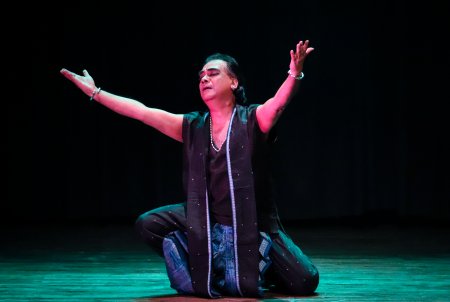 Ratikant Mohapatra He presented his signature number Sabari. His attempt at being a performer has borne fruit by his sheer determination and excellence. The piece from Tulsidas' Ramcharitmanas has hidden layers of meaning. Through his immortal poetry, he has been able to say that the soul never grows old though the physical body does. Rama, an incarnation of Vishnu himself, appears before the ever young soul of Sabari whose mortal body has become old and feeble. Sabari's clean mind does not take into account the petty rules of mortal man. She makes sure that Rama has the juiciest and sweetest berries. The story was evocatively depicted by Ratikant Mohapatra to the music composition of Rupak Kumar Parida. 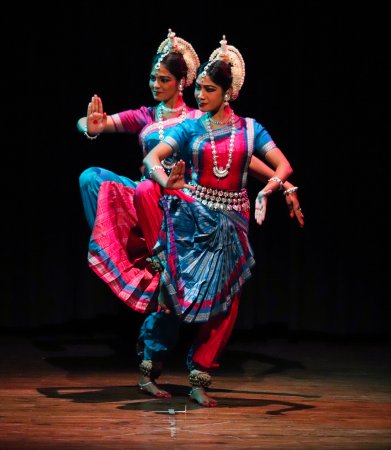 Aishwariya Singhdev and Preetisha Mohapatra In Ardhanarishwara of Adi Shankaracharya, Ratikant has explored the visual beauty of the male and female (Purusha and Prakriti) concept in one body. The piece described the iconography of the image of Shiva and Parvati who complement each other. The right half is Shiva's body adorned with ashes, snakes and flying hair - the left half is that of Parvati with turmeric and sandal paste, champak flower and dazzling jewels. The coming together of the essential male and female principles makes for the idealized form of a complete and evolved being. It was presented in duet by Aishwariya Singhdev and Preetisha Mohapatra. The duo matched each other in their rendition. In perfectly learnt Odissi style they brought home in clear terms that the right side was Shiva while the left was Parvati. Both moved in unison showing the adornment and characteristics of Shiva and Parvati. Virile Shiva was complemented with graceful Parvati. Their expressions and movements were matchless as they covered the stage as one inseparable body -not missing a step or losing balance, while at the same time blossoming in its beauty. The appreciative rasikas clapped several times as the duo maneuvered the different movements and freezes.  Paramita Maitra Paramita Maitra is a brilliant dancer. A Kathak exponent, choreographer, academician and the director of Nrityangan Kathak Kendra, Kolkata, Paramita started dancing at the tender age of seven and later on enriched her knowledge under the guidance of Kathak Guru Pt. Vijay Shankar of Lucknow gharana at Padatik Dance Centre. She has taken advanced training from Pt Birju Maharaj. Her repertory members performed "Baidyachitra" which suggested a picture painted by the musical drum with the brush of the ankle bells. A metaphorical parallel, the different musical beats played on pakhawaj, khol, tabla and dhol unleashed untold joy. Pakhawaj metaphorically was the male form, showing 'veer ras' performed in tandav nritya style composed in chautal of 12 beats. The melody of khol represented the female form showing 'Sringar ras' performed in graceful lasya style. Tabla represented both male and female united together like it is in the concept of Prakriti and Purusha. Finally 'Ulhas' represented by beats from the dhol, suggested outpouring of joy and happiness. In the end a point was reached, where ghungroo/ankle bells danced to the sensational moods of the drum. This music composition of Ashok Datta was conceptualized and choreographed by Paramita Maitra. The performers Reshmi Mitra, Sritama Banerjee, Nilopa Maitra, Sarodiya Dutta, Susanta Ghosh, Bishal Dutta, Shubhradip Shaw and Nilam Raj Roy wove an intricate web with their mastery of Lucknow gharana Kathak. 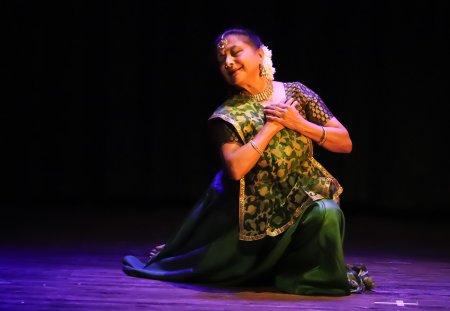 Saswati Sen Saswati Sen has spent more than five decades imbibing the Kathak art form from Pt Birju Maharaj. She has been the prime motivator in creating several popular events - such as the 'Walk for Art' in Delhi and Mumbai; camps in music-dance-painting; quiz competitions for school going students and other dance related activities. Saswati Sen gave a brief glimpse of the kind of abhinaya prevalent in the Lucknow gharana of Kathak with her rendition of "Kuru yadu nandana" from Jayadeva's Geeta Govinda. She recalled her time when Guru Kelucharan Mohapatra, the master abhinaya expert, inspired her to emote Radha bhava with the accuracy and style of Kathak. Hers was a super abhinaya rendition of the ashtapadi with the flavours of Kathak.  Tapati Chowdurie trained under Guru Gopinath in Madras and was briefly with International Centre for Kathakali in New Delhi. Presently, she is a freelance writer on the performing arts. |